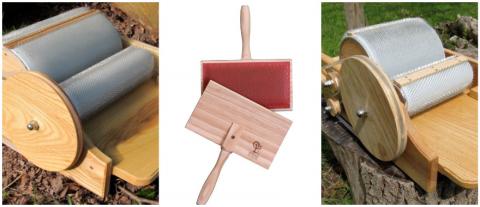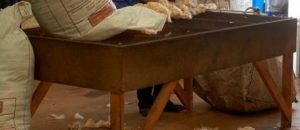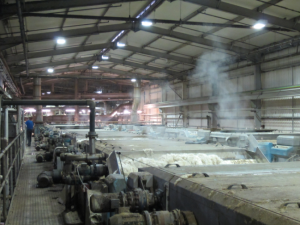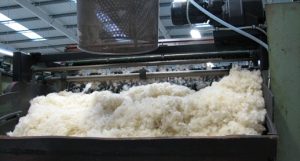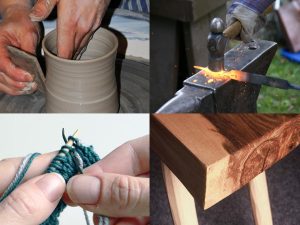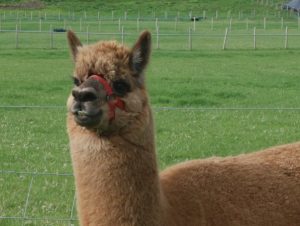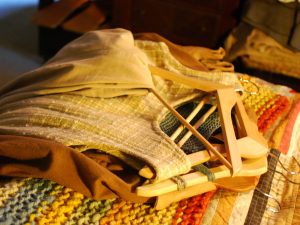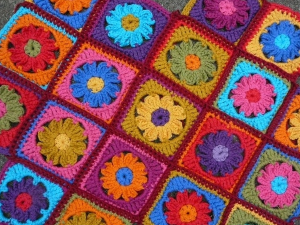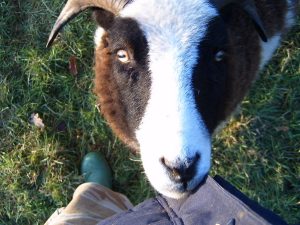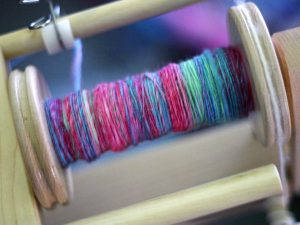In the tenth installment of The Wool Journey with Sue Blacker at The Natural Fibre Company, we learn about the next stage of preparing wool to spin, using traditional carding machines.
Now we have a pile of evenly organised fluff: clean, blended and oiled so that it will go through the next machines.
At a small scale, the clean fibre can be processed by hand using hand carders or a drum carder, with or without a small electric motor and also combed by hand using heavy worsted combs or the type of combs used to groom dogs and cats. There are even nice electrically driven spinning wheels! However, at The Natural Fibre Company we start with traditional large carding machines, which have not changed much in structure since they were invented in the second half of the eighteenth century by Lewis Paul and later also patented in various forms by Richard Arkwright and Samuel Crompton.
The above pictures are of hand carders made by Ashford, from The Threshing Barn(link is external) and drum carders fromThe Classic Carder(link is external) in Staffordshire.
Our machines are around 40 feet long and 60 inches wide (being Imperial machines!). In metric, they are around 14 metres long and 2 metres wide. Ours are probably at least 80 years old, which is quite typical, as apart from the iron frame most of the parts are replaceable. When the wire covering the rollers wears out the machine can be re-clothed, and all the belts, gears, chains and sprockets can also be replaced, along with the small electric motors which drive the various sections.

Credit: The Natural Fibre Company
The above is a simple schematic of a single swift carder from Pat Green Carders Ltd.
The Card for woollen spinning

Credit: The Natural Fibre Company
Above is the feed hopper and micro-weigh along with the first rollers, where the micro-weigh can be used to set yarn specification.
A Carding machine consists of a series of parts:
- Feed-in: this may be at the simplest just a moving conveyor or may include a single or double hopper, feed sheets and an automated weighing mechanism to regulate the flow of fibre and thus the thickness of the yarn to be made )see photos above)
- Scribbler: this is the first part of the machine and has a series of feed rollers before a two large rollers, called swifts (because they rotate quickly!) each of which is flanked over the top by 4-5 sets of workers and strippers, which are pairs of rollers which rotate in the opposite direction to the swift. The swift goes in the direction of travel of the fibre through the machine, so the workers and strippers slow and reverse the travel. The interaction of these rollers, carefully spaced to allow the wool to pass between them, will gradually spread out the wool with a progressively finer brushing motion, all finer than the Fearnaught. All of the rollers are covered with wire like a rather fierce form of Velcro with the wire graduated from coarser to finer through each part of the machine. Each set of swifts, workers and strippers then has a fancy (which has loose springy long wire like a hairbrush) and a doffer to pull the wool off and onto the next stage.
- Peralta: a spring loaded roller enabling remaining vegetation to be crushed so that it will fall out, called after its inventor, Antonio Peralta who created it in 1937

Credit: The Natural Fibre Company
- Scotch feed: (see photos above) an up-and-over mechanism drawing together the scribbled fibre and feeding it into the second part of the carding machine while at the same time laying it out across the direction of the machine, so that the fibre can be opened out in the opposite way (a bit like turning pastry as it is rolled out, to get it even)
- Card: this is another set of rollers identical to the scribbler but with finer wire as the wool is progressively opened out and smoothed out
- Condenser: the fibre has now been changed from a pile of fluff into an even web, even both across and along its length, so it can now be split down onto tapes and passed through rubbing rollers to make it hold together, before winding onto bobbins ready for spinning. At this stage the fibre may look like a yarn but will pull apart easily – there is just enough tension from the rubbing to hold it together to feed into the woollen spinning frame. At this stage the rolls of carded fibre on the bobbins are known as slubbings. For The Natural Fibre Company we have 96 ends: 12 each on 8 bobbins, to go to the spinning frame. Some carding machines may have more bobbins with more or less rolls of slubbings on each, depending on how the fibre is to go onto the spinning frame.

Credit: The Natural Fibre Company
Above are the condenser and final preparation of bobbins of carded fibre for woollen spinning.
The Card for worsted spinning and other things besides …
For worsted spinning, the fibre only goes through the Scribbler and Peralta and is then fed into a can or tub by means of a can coiling machine.
It is at this stage that the paths to the end product diverge:
- can coiling creates soft rovings which are also able to be used for woollen hand spinning or felting
- if the fibre also goes over the Scotch Feed it can be lapped into a box for felting flat
- alternatively the fibre may be just wound onto a big roller into a batt, which can then be cut off the roller and used for felting or wadding
- or of course it may go on further to be spun as a worsted style yarn
Combing and gilling
To make a worsted spun yarn, the can coiled rovings now travel through a series of further machines which refine and prepare the fibre for the worsted spinning frame.
At The Natural Fibre Company, we work through:
- the first gill – which aligns the fibres
- the comb – which combs out around 10-15% or sometimes more of the coarse and short fibre in the blend
- the second gill – which re-aligns the fibres
- the auto-leveller – which ensures the aligned fibre is evenly organised along its length
- the bi-coiler – which splits the aligned fibre into two halves ready for spinning
- to reach the spinning frame

Credit: The Natural Fibre Company
As you can see, the machines are all quite similar in appearance although they have different functions, and are the most usually found nowadays – the older-style Noble combs are very beautiful but much less used as they are more difficult to manage. One part of the gills is an item called the Ambler Superdraft, which was invented by an ancestor of Sue Blacker, whose maternal grandmother was an Ambler. Above are in order from the left the first gill, comb and second gill.
By passing the fibre through these machines, it is produced to a constant weight per metre and therefore thickness, so that when it reaches the spinning frame it will be able to spun to the required thickness or yarn specification. Fibre can enter the process at this stage as “tops” which are combed and gilled rovings, already prepared for setting the specification and spinning by specialist businesses called “top-makers”. Indeed much of the spinning industry is specialised, with dedicated scourers, blenders, top-makers, spinners, and then finishers so The Natural Fibre Company is unique in doing all of these processes under a single roof.
Through these processes it is also possible to add coloured fibre to white or to add other fibre such as nylon for sock yarns by combining the flows of rovings as they pass through the gills. It is also possible to re-comb to remove more coarse or short fibre, although of course this will reduce the resulting quantity of yarn. Below are combed tops ready for bi-coiling and spinning.

Credit: The Natural Fibre Company
For more information on worsted and woollen spun yarns and their characteristics, see our Information Sheet.
 About the author
About the author
As British wool spinners, The Natural Fibre Company add value by processing quantities of fleece from 20 kilograms up to over a tonne and more. As we scour, card, dye and woollen and worsted spin under one roof, we are effectively experts in all aspects of the process of turning raw fleece into high quality yarn. Most of our customers are in the UK for rare and specialist breeds.

